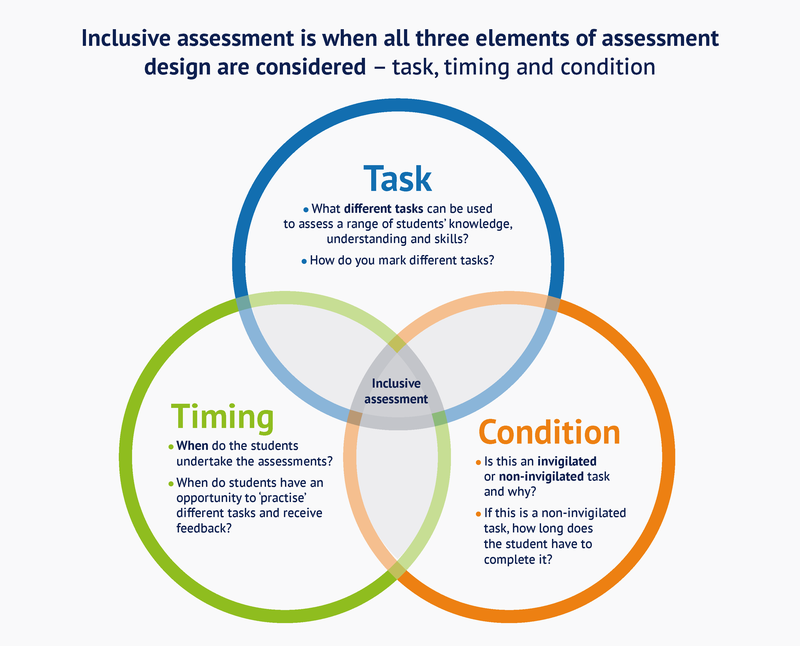IncludED: A guide to designing inclusive assessments
Creating an inclusive learning environment at Oxford where all students feel valued and that they belong
Types of summative assessment tasks
View a list of different types of summative assessment tasks in a range of formats (written, oral, practical) which can be used to promote inclusivity.
Assessment, rather than teaching, has a major influence on students’ learning. It directs attention to what is important. It acts as an incentive for study. And it has a powerful effect on what students do and how they do it (Boud & Falchikov, 2007).
What are inclusive assessments? (and why does it matter?)
Inclusive assessments focus on the ways in which assessment design can proactively minimise the likelihood of students being excluded, overlooked and/or disadvantaged through the ways in which they are assessed across their studies.
Inclusive assessments are those that incorporate a balance of assessment tasks (eg essay, problem set, dissertation) undertaken in different conditions (eg invigilated, non-invigilated) and with timings that are distributed across the years and/or terms of study for undergraduate and postgraduate taught provision.
The driving force behind inclusive assessment was originally focused on meeting the requirements for specific groups of students, for example, disabled students. However, inclusive assessment design is increasingly recognised as good educational practice and benefits all students (Hanesworth, 2019).
...shifting to inclusion in assessment moves past responding to the needs of a single equity group, or a reactive stance where diversity is reduced to a narrow set of categories, to creating assessments that are accessible for a wide range of students (Tai et al, 2022).
Inclusive assessment is therefore not about catering for specific individual differences through case-by-case adjustments to assessment. Rather, it’s about being proactive in approaches to assessment design from the outset. Inclusive assessment design provides all students with equal opportunities to demonstrate their learning and achievements and it reduces the need for individual adjustments to assessments (Tai et al, 2022). Crucially, inclusive assessment can also contribute towards reducing awarding gaps (Kaur et al, 2017; Mountford-Zimdars et al, 2015).
Inclusive assessment does not equate to lowering academic standards. Adopting principles of inclusive assessment design can, in fact, maintain standards whilst also generating more opportunities for students to demonstrate the breadth and depth of their learning (UUK & NUS 2019). After all, no single assessment task can capture effectively what a student knows, understands and can do to their full potential; over-reliance on one, or a limited number, of assessment tasks narrows the range of opportunities for students to demonstrate the full extent of their learning. The following section describes practical ways in which assessments at Oxford can be designed/re-designed to be more inclusive.
What can I do to make assessment more inclusive?
Assessment can be made more inclusive by incorporating a more diverse range of summative assessment tasks to assess students’ learning. Summative assessments are those which contribute to a student’s final degree classification. When assessments are also designed to incorporate authentic elements, in which students need to apply their learning to ‘real-world’ or simulated contexts, it can strengthen the academic integrity of a given assessment and thus reduce opportunities for academic misconduct (Sotiriadou et al, 2020).
For each specific summative assessment task that students undertake, for example, field report, oral presentation, essay etc, there are two factors to consider in supporting more inclusive assessment design. These are:
- the conditions in which the assessment task is undertaken, for example, coursework; invigilated exams (open/closed-book), non-invigilated open-book exams etc
- the timing of the assessment tasks, for example, are summative assessment tasks spread out over the year/programme, or do they take place in an intense period during the academic year?

What are examples of different summative assessment tasks to promote inclusivity I can use?
Over-reliance on one, or a limited number, of assessment tasks narrows the range of opportunities for students to demonstrate the full extent of their learning. For example, students may currently be asked to complete tasks such as essays, problem sets or practicals in closed-book invigilated conditions, often timed to take place at the end of a course/programme of study. There are, however, a range of other assessment tasks, conditions and timings that contribute to promoting a more inclusive assessment profile across a course/programmes which can assess the same/similar skills and understanding, and which are equally academically challenging and robust.
You can view a table outlining different assessment tasks in a range of formats (written, oral, practical) that can be used to summatively assess students learning at Oxford. It would, of course, be neither academically appropriate, nor feasible, to incorporate all these different assessment tasks into a single course/programme of study. The aim of this table is therefore to provide a starting point for considering how assessments may be diversified through systematic design/re-design to promote further inclusivity across a course/programme of study.
How can I develop assessment criteria for different tasks?
An important element of good assessment design is the development of clear assessment criteria for different tasks for different conditions. Assessment criteria clarify for markers and students the qualities and expectations of submitted work at different grade levels for given tasks as applicable to the timings and conditions in which they are completed.
Assessment criteria help students to develop their understanding of what excellent assessed work looks like in their discipline or profession. It is important to consider how and when the assessment criteria are developed and shared with staff and students. The Centre for Teaching and Learning has developed a practical guide to support students’ understanding of assessment criteria at Oxford.
It’s also important in assessment design to think also about where, when and how students are supported (‘scaffolded’) to prepare for their summative assessments. For example, consider what opportunities exist for them to engage in formative assessment activities, that is, those which do not contribute to the degree classification, and receive feedback on this work to support their learning and progression.
Next steps: Where can I find out more about inclusive assessment?
To find out more about inclusive assessment, you can:
- Read the Guide to inclusive teaching
- Read Giving effective feedback
- Enrol in the short online Canvas course: An Introduction to inclusive teaching at Oxford (SSO required)
- Read papers on assessment developed by the Cambridge Centre for Teaching and Learning: Foundations for Assessment: terms and concept papers
- Read a research paper by Joanna Hong-Meng Tai et al, 2022: Designing assessment for inclusion: an exploration of diverse students’ assessment experiences.
Next steps: What support is available if I want to redesign summative assessment?
The Centre for Teaching and Learning offers a consultancy service in support of redesigning summative assessments. The Centre will work with a department or faculty to provide pragmatic and effective educational change that is aligned to current strategic priorities as appropriate to the disciplinary context. Find out more about the Centre for Teaching and Learning's consultancy service.
Contact us
If you have a query, please contact us at
Stay informed



